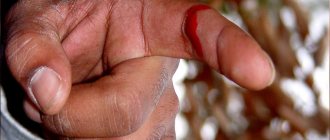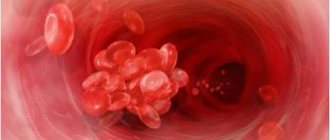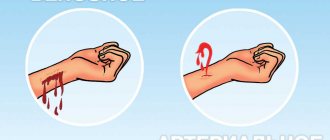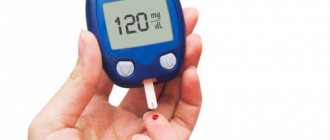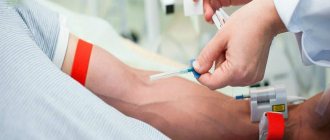What to do if you have a nosebleed
The first step is to determine how serious the situation is. Pay attention to when the bleeding occurred and how intense it was.
It happens that the blood drips a little and stops on its own. It is also possible to stop minor bleeding on your own. If the bleeding is heavy and is accompanied by other signs (serious damage to the skin, fainting, darkening of the eyes, hysteria or increased blood pressure) or the bleeding is complicated by chronic diseases of the blood or cardiovascular system, you must urgently call an ambulance and follow the instructions of the telephone operator before arrival doctor
How can you cope quickly?
Now you need to figure out what to do if your nose bleeds. You can eliminate the symptom as quickly as possible using the presented algorithm:
- The patient’s condition is assessed: the probable cause is determined (trauma, foreign body, inflammation, overheating, etc.), accompanying symptoms (changes in skin color, shortness of breath, increased heart rate, etc.), general well-being.
- If there is anterior bleeding, apply a cold compress to the nose area. Thanks to this, it will be possible to narrow the blood vessels and slightly reduce the swelling of the mucous membranes. The duration of exposure is no more than 15 minutes.
- Next, you need to insert a tampon into your nose. It is pre-impregnated with either peroxide or a hemostatic compound.
- For moderate and severe conditions, doctors anemize the mucous membranes in the affected area using ephedrine or adrenaline. It is dangerous to use medications on your own.
- If there is no effect from the measures taken, then anterior type tamponade is performed.
This measure of influence often creates a positive effect on posterior nosebleeds. If there is no positive effect, posterior tamponade is performed. If the patient has no experience or the bleeding is intense, then it is better to decide what to do directly from the doctor in the office.
Important! If these measures have not shown effectiveness or the blood flows heavily, doctors may decide to perform surgery - endoscopic coagulation, cryodestruction, etc.
Causes of nosebleeds
Take a look at this list. Each of the points can cause nosebleeds.
- Overheating of the body;
- Avitaminosis;
- Reduced blood clotting;
- Weak blood vessels;
- Nose injury;
- Inflammatory processes in the nasal passage;
- High blood pressure;
- Pathologies of the cardiovascular system;
- Existing serious diseases, for example: leukemia or anemia;
- Reduced level of platelet production in the body;
- Taking medications;
- The presence of a tumor in the nasal passage.
Causes
The nose is an important sensory organ that not only prevents infection from entering the body. The nose contains many nerve endings and blood vessels. This is why any injury can cause severe bleeding. Doctors divide nosebleeds into two types:
- Bleeding arising from local causes that exclusively affect the nose.
- Bleeding that begins for internal reasons, affecting the entire body.
Local causes include various injuries. For example, a blow to the nose or foreign objects entering it. Acute sinusitis and rhinitis are considered secondary causes. At the time of these diseases, a crust appears inside the nose, due to which the nasal mucosa is injured.
During an allergy, blood flow to the nose increases significantly, and the vessels, in turn, simply cannot cope with the pressure. This is why allergy sufferers complain a lot about nosebleeds. Various implants and operations in the nasal area are considered common causes of this problem. During the period when the nose is healing, some adaptation of the blood vessels usually occurs, so bleeding appears quite often. If you have had nose surgery, it is better to check with your doctor in advance what will be normal for you in the future and what to worry about
Unfortunately, internal causes of nosebleeds are not as easily determined as local ones. Bleeding is often a symptom of other diseases, such as the cardiovascular system. Blood from the nose often occurs in hypertensive and hypotensive patients, who are characterized by increased sensitivity to pressure changes.
Common causes that cause nosebleeds:
- dysfunction of blood clotting;
- vitamin deficiency (PP and C);
- inappropriate use of medications that affect blood pressure or blood clotting;
- various thermal effects, for example, overheating in the sun;
- change in pressure (for divers);
- fever in severe viral infections;
- hormonal imbalance;
- recent birth or current pregnancy.
What can precede a nosebleed?
Sometimes before the onset of nosebleeds, a headache begins, discomfort in the nasal cavity is felt, dizziness or tinnitus occurs. The presence of at least one of these signs may indicate the imminent onset of bleeding.
This situation can happen to anyone, but this situation raises the most questions when it occurs in a small child, during pregnancy, or with high blood pressure.
What to do if your child has frequent nosebleeds?
If a child or adult is worried that blood often starts coming from the nose, the first thing to do is find out the reason.
- If frequent bleeding is associated with a low platelet count, your doctor will order tests to determine the diagnosis.
- If the causes for you or your child are related to local factors - for example, the vessels are located close to the mucous membrane, the doctor may suggest coagulation
- cauterization of the nasal mucosa. This can be done in various ways: using liquid nitrogen, cauterization with a laser, or electrocoagulation. But to carry out these procedures, strict indications are required. - If the nose bleeds frequently and there is significant blood loss, surgery is recommended. During this operation, vessels and arteries are ligated (thrombosed), which leads to the formation of blood clots - new nodules (clots).
How to stop nosebleeds in young children
- To begin, the child must be seated so that the blood can flow out freely.
- Ice should be placed on the bridge of the nose, neck or forehead. If it is not there, you can take any cold product from the refrigerator. Your feet should be warm at this time.
- Press the wing of the nostril from which the blood is coming out against the septum for 15 seconds. During this time, the bleeding should stop.
- If the bleeding is heavy, place a tampon soaked in a small amount of hydrogen peroxide (just salt water will do) in the nostril, or use vasoconstrictor drops.
To prevent this condition, it is important for the child to spend more time in the fresh air (in any weather). Swimming and hardening are great for strengthening blood vessels. Periodically humidify the air in the room where the child spends most of the time. It is important that his diet is varied and contains all the necessary microelements and vitamins.
In young children, nosebleeds are often caused by frequent nose picking. Make sure your child doesn't do this. If the cause of the problem is physical activity, it is necessary to review the baby’s daily routine and reduce it.
Types and causes of epistaxis
Before stopping nosebleeds, figure out where they are coming from. Blood can come from both the front and back of the nose.
The first type is considered the most common; it is also harmless and goes away immediately. It is easily determined: bleeding comes from the nose, the blood flow is concentrated in the anterior part of the medial wall.
Bleeding from the back end poses a threat to the body because it does not appear outwardly. Preliminary signs of a problem include black stool, vomiting, and coughing up blood. If you have difficulty stopping the flow and have these symptoms, you should visit your doctor immediately.
What leads to nosebleeds are, first of all, reasons such as:
- hormonal imbalances;
- lack of vitamin K;
- skewed nose bridge;
- different types of polyps;
- overheating of the body;
- improper blood clotting;
- taking anticoagulants;
- temperature fluctuations;
- extreme fatigue;
- the presence of hemorrhagic diathesis;
- the presence of adenoids, rhinitis;
- the presence of hypertension and vegetative-vascular dystonia.
How to stop nosebleeds during pregnancy
Sit so that it flows freely from the nasal cavity. Next, follow the instructions below.
First, close both nostrils for 15-20 seconds. If this doesn't help, try inserting a wet swab soaked in salt water or hydrogen peroxide into your nose.
Ice applied to the bridge of the nose helps a lot. You can press on your upper lip and hold your finger there for 20 seconds. During this time, the bleeding should stop. Otherwise, it is recommended to call a doctor.
Help
The most common bleeding is from the anterior third of the nose. In such a case, it is not difficult to provide first aid and the bleeding stops quite quickly. Epistaxis from the posterior part of the nose poses a great danger to people. Here the blood flows from large vessels, and stopping it is problematic. This kind of bleeding can occur completely unnoticed by the patient. Blood oozes down the back of the throat and then into the stomach. Only bloody vomiting can be alarming.
In many cases, a stream of blood flows from only one nostril. Pathology is caused by injuries to the nose and head, sudden changes in pressure or fragile walls of blood vessels.
First aid for any nosebleeds consists of the following:
- The victim is seated comfortably on a chair, with the head slightly tilted forward. You should not tilt your head back, as in this case it will be difficult to control the blood volume.
- The injured person needs to hold his nose below the bridge of the nose for 10 minutes. At this time you need to breathe through your mouth. There is no need to make active swallowing movements or talk. All this greatly interferes with the formation of a normal blood clot.
- Ice wrapped in a cotton napkin should be placed on the bridge of the nose. If there is no ice in the house, then apply any cold foods or cool metal objects.
- Gauze swabs soaked generously in hydrogen peroxide are inserted into the nasal passages. Usually the bleeding stops within a couple of minutes.
If the bleeding cannot be stopped within half an hour, the victim must be urgently taken to the hospital or call an ambulance. If there is significant posterior bleeding, complex nasal packing is required, which only a medical professional can do.
If the cause of bleeding is prolonged exposure to the sun, the victim should be moved under a tree or indoors. First aid consists of the following measures:
- The victim’s limbs and head are wiped with a napkin soaked in cool water.
- Turn on the fan and direct it towards the victim.
- They give you a lot to drink. The drink should not be very cold.
Sometimes the victim is moved indoors and the air conditioning is turned on.
This must be done with great care; icy air should not blow on a person; rapid temperature changes will not lead to anything good.
If, after a strong blow to the head, there is a yellowish discharge, you should immediately go to the hospital. This may be a symptom of a calvarial fracture.
Hypertension may also be the cause of excessive bleeding from the nose. In this case, in addition to standard primary care, the person is given medications that he regularly takes. In most cases, epistaxis promotes a rapid decrease in blood pressure.
If the cause of your nosebleed is a foreign body, you should not try to remove it yourself. This will lead to mucosal injuries and worsening of the condition. In addition, a foreign body can move into the lower respiratory organs, which will lead to an attack of suffocation.
All measures to stop bleeding can be divided into local and systemic. In the first case, all first aid is based on actions directly with the nose. In the second case, they resort to injections and tablets. So, to eliminate bleeding, 10% calcium chloride can be prescribed; it is administered to the patient intravenously. Other hemostatic drugs may also be prescribed. In severe cases, blood transfusions are resorted to.
If a person is prone to nosebleeds, they are prescribed medications containing vitamin C. This is necessary to strengthen the walls of blood vessels.
What could make matters worse?
When trying to stop a nosebleed, certain factors can make the condition worse.
- Blood must not be allowed to enter the respiratory tract. To do this, when lying on the bed, raise the head of the bed with a high pillow. It is also not recommended to throw your head back. The blood must be spat out.
- When lying down, raising your legs leads to a redirection of blood towards the head, and this can provoke a new nosebleed. Avoid this position when stopping bleeding.
- Severe anxiety and drinking tea or coffee increases blood pressure. Try to calm down and avoid drinking these drinks to avoid increased blood flow.
- When the bleeding stops, a crust forms in the nose, which, like a plug, stops the bleeding. If you try to blow your nose immediately afterward, you may bleed again. So, don't rush to blow your nose.
Preventive actions
Correct actions after stopping epistaxis prevent relapse. The victim lies down on the bed so that the head is 45 degrees above the body. It is forbidden to blow your nose or strain your nasopharynx in any other way. Other recommendations on how to stop and prevent repeated epistaxis are as follows:
- you should not strain excessively during the act of defecation;
- people who often experience constipation take appropriate medications;
- the head should always be kept above the level of the heart, which normalizes the level of pressure in the blood vessels;
- if your nose bleeds, then fans of tobacco and alcohol should think about the need to give up bad habits, otherwise a relapse cannot be avoided;
- after eliminating nasal epistaxis, you should not drink or eat hot foods for 30 hours;
- It is prohibited to take medications that affect the rate of blood clotting without a doctor’s permission.
People who have the problem frequently should talk to an ENT specialist. The doctor will tell you what to do if the patient often has nosebleeds. Separately, the specialist will tell you about the need for timely removal of dried blood from the nasal passage - a breeding ground for pathogenic cultures. You can quickly solve the problem with hydrogen peroxide.
Nosebleeds occur under the influence of external and internal factors. In order to quickly stop it, you need to control yourself. You can’t throw your head back, which will only worsen the situation. A cold towel or ice is placed on the bridge of the nose. The duration of the procedure is no more than 10 minutes. Then the towel is removed, otherwise a cold burn will form. People diagnosed with chronic diseases, such as hypertension, should keep medications on hand. As soon as epistaxis has made itself felt, do as the doctor recommended. In a difficult situation, when the heavy bleeding could not be stopped on its own, an ambulance is called.
When to see a doctor
Medical assistance is necessary if:
- When trying to stop nosebleeds, you feel a wound or some kind of damage in the nasal cavity;
- The bleeding lasts more than 15 minutes and you are unable to stop it;
- You have frequent nosebleeds (repeatedly during the week, for no obvious reason).
First aid, if not just walking, but running
Regardless of the severity of blood loss, first aid is mandatory.
But the speed and quality of manipulations are especially important for light, moderate and massive bleeding. In the first case, about 500 ml flows out, in the second - 1000-1400 ml, and in the third - over 1400 ml. If in the first case it is possible to cope without outside help, then in case of severe manifestations it will not be possible to eliminate them without an ambulance. After calling the service, the necessary assistance is provided to the patient until it arrives. An approximate algorithm of what to do if your nose is bleeding:
- In case of increased bleeding, it is recommended to place tightly rolled turundas into the cavity. They are first dipped in vegetable (preferably sea buckthorn or rosehip) oil, or in weak peroxide. If these products are not available, you need to moisten them in clean water.
- Turunda should be kept for up to half an hour, waiting until the blood stops flowing.
- Next, you should carefully pull them out. If tampons have dried to the mucous membrane, they cannot be torn off. In this case, you must first soak them with water, dripping it onto the outer part of the turunda.
If the inserted tampons are pulled out abruptly, the mucous membrane and blood vessels are injured - as a result, the nosebleed will not stop; on the contrary, it will intensify. If the measures taken do not lead to positive results, then only an emergency doctor will have enough experience and qualifications to stop nosebleeds with medication and with the help of special means.
Red brush for men and women. Harm from smoking hookah and electronic cigarettes.
Traditional ways to stop nosebleeds
The standard recommendations were listed above, but it is possible to turn to effective traditional medicine.
Try putting freshly squeezed lemon juice on your nose, a few drops in each nostril. You can dip a cotton swab in lemon juice and insert it into your nose for a few minutes. Change it if necessary.
If you have nettle on hand (let's say you are in nature), squeeze the juice out of it and insert a cotton wool soaked in this juice into your nose.
Some people successfully stop nosebleeds using the su-jok system. To do this, you need to bandage your thumb approximately at the level of the middle of the nail (use a rubber band or twine for this) and hold it there for 10 minutes. According to the su-jok technique, in this place there is a reflex zone corresponding to the area of the nose.
First aid for nosebleeds - step-by-step instructions
Most often, a nose bleeds from a blow or as a result of another injury. Blood loss in this case is profuse. That is why, before medical workers arrive, you need to try to help the victim and try to stop the nosebleed on your own. How can you alleviate his condition? Below is a step-by-step algorithm, following which you can quickly stop bleeding.
- A person who is bleeding should be seated with his head slightly tilted down.
- The patient should be undressed to the waist to make breathing easier.
- You need to open the windows in the room to let more air in.
- If the victim cannot sit, then he is laid down. It is better if a high pillow is placed under your head.
- The patient's head should be turned to the side to avoid blood flowing into the larynx.
- After all of the above measures, the blood pressure will weaken and eventually stop completely.
If the bleeding from the nose does not stop, it is necessary to prepare turundas (twisted gauze tourniquets) and moisten them in a 3% solution of hydrogen peroxide. Tampons are inserted into each nostril and held until the bleeding stops. What to do if your nose is bleeding and you don’t have anything on hand? You can simply press the wings of your nose tightly with your fingers for a few minutes. There is no need to apply too much force, as there is a risk of damaging the thin capillaries.
How to stop severe nosebleeds? To do this, you will need an ice pack or just a towel soaked in ice water. A cold compress is placed on the neck or bridge of the nose and held. The cold procedure time is 10 minutes. During this time, the burst vessel should stop bleeding.
You can quickly stop nosebleeds using special drops. They must have a vasoconstrictor effect. A hemostatic compress is performed as follows. A piece of cotton wool is moistened in the chosen preparation, then inserted into each nostril. Turundas should not remain in the nose for more than half an hour. Once the time is up, the tampons are carefully removed. In such a situation, the following medications can be used:
- "Tizin";
- "Nazivin";
- "Xylene";
- "Naphthyzin."
Many ready-made first aid kits sold through the pharmaceutical chain contain a hemostatic sponge. You can use it to stop nosebleeds in an adult. A small piece of such a sponge is placed in the nasal passage and lightly pressed with a finger. After a few minutes, you may notice that there is no bleeding.
Usually, with the correct actions and use of the listed first aid techniques, the patient’s condition returns to normal within a few minutes. If blood continues to flow through the nose, you must urgently contact a medical facility, or call a medical team to your home. If nosebleeds occur in a pregnant woman, you should not stop it yourself. You can only apply cold ice and urgently show the patient to the doctor.
Drugs to stop bleeding
How to stop nosebleeds in an adult if there is no positive dynamics using standard methods? In this case, the use of certain medications that can constrict blood vessels, accelerate coagulation processes and provide other beneficial effects is indicated:
- The main drug used to stop nosebleeds at home is hydrogen peroxide (3%). Take the drug into a small container, moisten a cotton-gauze swab in the solution and insert it deep into the nasal cavity. Additionally, you can squeeze the wings of your nose with your fingers. Thanks to this, the blood stops faster because the vessels are compressed. Duration of application is 15-20 minutes. After this, the tampon should be removed, because if the blood stops, the villi will dry to the mucous membrane, and removing them will be problematic. Use hydrogen peroxide with caution.
- Vasoconstrictor drops. If hydrogen peroxide does not help, you can stop the bleeding using drugs that have the ability to constrict small vessels in the nasal mucosa. To do this, you need to inject 1-2 drops of Naphthyzin, Galazolin, Rinazolin, Sanorin or another drug with similar properties into each nostril. But they must be used with caution.
- How to stop nosebleeds in adults? The real salvation will be the use of Aminocaproic acid. It is advisable to use this remedy on the recommendation of a doctor, especially if a similar problem recurs periodically. The drug belongs to the group of antihemorrhagic drugs and is intended for intravenous administration. But it is impossible to make such an injection on your own, so the medicine can be used in another way: inject a few drops into each nostril. After this, the bleeding should stop.
- How to stop severe nosebleeds? For this purpose, hemostatic drugs can be used. An effective remedy, Dicinon, which is available in 2 dosage forms - tablets and solution for injection. In case of severe bleeding, the drug is used not only to provide emergency assistance, but also for several days after the main problem has been eliminated. However, this can only be done in consultation with a doctor, so as not to cause adverse reactions or harm the body.
- Stopping bleeding can also be done with the use of Vikasol. But the product is not intended for emergency use, since the therapeutic effect of its use appears after 12 hours. The need to prescribe it arises with prolonged bleeding. It cannot be used without the consent of a doctor.
- If your nose is bleeding, you can use special hemostatic sponges. Most often, these products are used for children, but they are quite suitable for adults. Hemostatic sponges have the unique ability to self-resolve, so there is no need to remove them from the nasal passages. This makes them convenient to use when a problem arises.
What to do if there is bleeding caused by high blood pressure? In this case, it is advisable to use antihypertensive drugs with further consultation with a specialist. When bleeding occurs, it is necessary to remove the cause of its occurrence by using drugs that lower blood pressure, thereby reducing the load on the blood vessels. If you have high blood pressure, a person must strictly adhere to the doctor’s recommendations and take all prescribed medications strictly according to the treatment regimen. Antihypertensive drugs include Clonidine, Corinfar, Dibazol, Magnesium Sulfate, etc. It is necessary to reduce blood pressure, but this must be done under the supervision of a doctor.
Traditional methods
If a nosebleed occurs, what should you do to quickly stop it? You can use folk remedies that have been tested for centuries. Many plants have a hemostatic effect. Juice, decoctions and infusions based on them are used for local and internal use. How to stop bleeding? The following may help:
- Quick results can be easily achieved with nettle juice by squeezing it from a fresh plant. Soak cotton pads with juice and insert into the problematic nasal passage. Duration of application is 10-15 minutes. If necessary, repeat the procedure using new nasal swabs. It has been used since time immemorial and is popular today as the most effective hemostatic agent.
- How to quickly stop bleeding? Yarrow will have a good effect. The plant must be washed under running water and passed through a meat grinder, squeeze out the juice and inject 5-7 drops of liquid into each nasal passage.
- Lemon juice has a positive effect. But it cannot be used in its pure form, because... You can get a burn to the mucous membrane. The juice is diluted with boiled water in a ratio of 1:2.
- Aloe is used in a similar way. For this, it is advisable to use an adult plant that has reached 3 years of age.
- To prevent blood from flowing, you can use a decoction of comfrey: 1 tbsp. l. dry raw materials, pour 1 cup of boiling water, leave, strain and drop into both nostrils.
Specifics of nosebleeds in pregnant women
Bleeding increases during the 6th–7th month of pregnancy, which is associated with an increase in the volume of circulating blood and changes in its hemodynamic parameters. The flow of blood to the head is usually caused by angioneurosis, associated with a reaction to the release of adrenaline.
In pregnant women, the position of the sacrum changes, the curvature of the spine increases, the muscles under the back of the head spasm, and therefore the regulation of vascular tone is disrupted. But these are temporary phenomena.
Acupressure points should not be used on pregnant women as they can cause hormonal reactions. It is recommended to spend more time on prevention: humidify the air, smear your nose with Vaseline, drink plenty of fluids. It is recommended to eat protein foods and greens, as they contain vitamin K, which is beneficial for the hematopoietic system.
